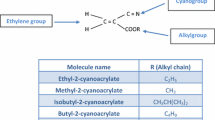Abstract
The success of every intestinal surgical procedure primarily depends on correct technical execution of the intestinal sutures. Despite the continuing improvements in intestinal synthesis techniques and the introduction of mechanical staplers, the risk of anastomotic dehiscence remains a major concern. For high-risk anastomoses, defined as those performed under critical conditions, n-butyl-2-cyanoacrylate tissue adhesive allows for quick sealing of the two stumps and supports the physiological wound-healing process. Furthermore, no experimental or clinical studies have shown that this glue has any carcinogenic or mutagenic properties. Thus, we believe that n-butyl-2-cyanoacrylate will be extremely useful for intestinal anastomoses with a high risk of dehiscence.
Similar content being viewed by others
References
Toriumi DN, Raslan WF, Friedman M, Tardy ME (1990) Histotoxicity of cyanoacrylate tissue adhesives. Arch Otolaryngol Head Neck Surg 116:546–550
Bonutti PM, Weiker GG, Andrish JT (1988) Isobutyl cyanoacrylate as a soft tissue adhesive. An in vitro study in the rabbit Achilles tendon. Clin Orthop Rel Res 229:241–248
Vezin WR, Florence AT (1980) In vitro heterogeneous degradation of poly(n-alkyl-ε-cyanoacrylates). J Biom Mater Res 14:93–106
Bischoff F (1972) Organic polymer biocompatibility and toxicology. Clin Chem 18:869–894
Fisher AA (1985) Reactions to cyanoacrylate adhesives: “instant glue”. Cutis 1:18–22
Greer R Jr (1975) Studies concerning the histotoxicity of isobutyl-2-cyanoacrylate tissue adhesive when employed as an oral hemostat. Oral Surg 40:659–669
Kante B, Couvreur P, Dubois-Krack G, De Meester C, Guiot P, Roland M, Mercier M, Speiser P (1982) Toxicity of polyalkylcyanoacrylate nanoparticles. I: Free nanoparticles. J Pharm Sci 71:786–790
Lehman RAW, Hayes GJ, Leonard F (1966) Toxicity of alkyl-2-cyanoacrylates. I. Peripheral nerve. Arch Surg 93:441–446
Papatheofanis FJ (1989) Cytotoxicity of alkyl-2-cyanoacrylate adhesives. J Biomed Mater Res 23:661–668
Woodward SC (1968) Physiological and biochemical evaluation of implanted polymers. Ann NY Acad Sci 146:225–250
Carmignani G, Belgrano E, Puppo P, Giuliani L (1978) Cyanoacrylates in transcatheter renal embolization. Acta Radiol Diagn 19:49–56
Andersen M, Binderup ML, Kiel P, Larsen H, Maxild J, Hansen SH (1982) Mutagenic action of methyl-2-cyanoacrylate vapor. Mutat Res 102:373–381
Lehman RAW, West RL, Leonard F (1986) Toxicity of alkyl-2-cyanoacrylates. II. Bacterial growth. Arch Surg 93:447–450
Vinters HV, Galil KA, Lundie MJ, Kaufman JCE (1985) The histotoxicity of cyanoacrylates. Neuroradiology 27:279–291
Berthelemy C, Audigier JC, Fraisse H (1983) A non-tumoral esophago-bronchial fistula managed by isobutyl-2-cyanoacrylate. Endoscopy 15:357–358
Hachida M, Naruns P, Morris S, Cochran AJ, Morton DL (1987) Bronchial anastomosis with a tissue adhesive. J Thorac Cardiovasc Surg 93:344–349
Middleton WG, Wayne M, Chiasson DA (1991) Histoacryl glue in microvascular surgery. J Otolaryngol 20:363–366
Prahlow JA, Lantz PE (1993) Cyanoacrylate adhesive technique in wound edge approximation. J Forensic Sci 38:1507–1512
Quinn JV, Drzewiecki A, Li MM, Stiell IG, Sutcliffe T, Elmslie TJ, Wood WE (1993) A randomized, controlled trial comparing a tissue adhesive with suturing in the repair of pediatric facial lacerations. Ann Emerg Med 22:1130–1135
Sohendra N, Nam VC, Grimm H, Kempeners I (1986) Endoscopic obliteration of large esophagogastric varices with bucrylate. Endoscopy 18:25
Matsumoto MT, Pant KC, Hardaway RM, Leonard F (1967) Closure of gastrointestinal perforations with cyanoacrylate tissue adhesive. Arch Surg 94:184–186
Pitzalis M, Intini L, Catalano G, Memeo V, Zamparese F, Sbiroli C, Di Rienzo G (1978) Sull'impiego di una colla particolare (Histoacryl azzurro) nelle sintesi intestinali (risultati istologici). Chir Gastroenterol 12:666–679
Bertolotto E, Botta L, Torelli P, Buscaglia M, Steinweg M (1981) La validità nell'uso dell'adhesive tissue (Histoacryl-Braun) e sua importanza come elemento di sicurezza nelle anastomosi difficili. Min Chir 36:1–4
Catona A, Tinozzi S, Valesi MG, Puntillo A, Beniglia E (1983) Contributo sperimentale e clinico sull'uso di un collante (Histoacryl-Blau) nelle anastomosi intestinali. Chir Ital 33:639–646
Author information
Authors and Affiliations
Rights and permissions
About this article
Cite this article
Tebala, G.D., Ceriati, F., Ceriati, E. et al. The use of cyanoacrylate tissue adhesive in high-risk intestinal anastomoses. Surg Today 25, 1069–1072 (1995). https://doi.org/10.1007/BF00311697
Received:
Accepted:
Issue Date:
DOI: https://doi.org/10.1007/BF00311697




